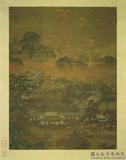明彭年錢榖鶴林玉露一則書畫合璧 卷
推薦分享
資源連結
連結到原始資料 (您即將開啟新視窗離開本站)後設資料
- 資料識別:
- 故畫001107N000000000
- 資料類型:
- 類型:繪畫、書法
- 型式:靜態圖像、文字
- 著作者:
- 彭年、錢榖
- 主題與關鍵字:
- 庭院 楊柳 香爐.火盆 橋 竹 瀑布 農夫 桃花 仕女 文房用具 牧童 牛 飲食器 耕織漁獵 籬笆、圍牆 傢俱(屏風) 雞 鹿 房舍 松 文玩(琴棋書畫) 鳥籠 高士(士人、隱士) 侍從(侍女、童僕) 溪澗、湍泉
- 出版者:
- 數位化執行單位:國立故宮博物院
- 格式:
- 畫幅 28.4x392.5 公分、書幅 28.5x101.8公分、隔水一 15公分、隔水二 4.6公分、隔水三 4.9公分
- 關聯:
- 石渠寶笈續編(寧壽宮),第五冊,頁2870&* 彭年(西元一五○五─一五六六年),長洲(今江蘇蘇州)人。字孔嘉,書法晉人,著有﹝龍池山樵集﹞。錢穀(西元一五○八─一五七二年),長洲人。字叔寶,文徵明弟子,山水爽朗可愛。 ﹝鶴林玉露﹞,書名,宋羅大經所著。此則繪其中一段小文,為羅氏自敘山居生活者。畫筆疏朗而蒼勁,為錢彭之合作,書亦雅秀。據彭題紀年,則此幅成時,彭年六十一歲,錢穀五十八歲。彭年於書成之次年即物故矣。 &* Ch’ien Ku was a native of Ch’ang-chou. His style name was Shu-pao. A student of Wen Cheng-ming (1470-1559), he excelled in landscape painting. P’eng Nien also was a native of Ch’ang-chou (modern Soochow). His style name was K’ung-chia. He modelled his calligraphy after that of Wang Hsi-chih (4th century). “Jade Dew in the Heron Grove” is the title of a book written by Lo Ta-ching of the Southern Sung (1127-1279). This calligraphy and painting, based on a story in Lo’s book, describes life in Lo’s mountain dwelling. The brushwork in the painting is fluent yet strong. The painting is complemented by P’eng’s elegant calligraphy. At the time the scroll was executed, P’eng Nien was 60 and Ch’ien Ku was 57. P’eng died the following year. &* 錢穀(西元一五0五─一五七八年),江蘇長洲人。字叔寶,自號磐室。少孤失學,及長,遊文徵明門下,讀書之餘,兼習繪畫。山水、蘭、竹俱能。山水以筆墨爽朗見長,運筆布墨,皆較乃師放縱。 本幅後方彭年所書跋中,謂係沈玄圃請彭年書「鶴林玉露」一則,由錢穀就文意作畫。本幅長卷,畫幅由右至左開展,符合故事敘述。是以文中如汲泉、讀書、與麋鹿共遊、濯足、印月,均能一一表現。展卷所觀,一如讀文章之歷程,而轉成圖像。畫風則一乃師門。 &* Ch’ien Ku (style name Shu-pao; sobriquet Ch’ing-shih) was a native of Ch’ang-chou, Chekiang. As a child he was orphaned and did not attend school. Later he received both literary and painting instruction from Wen Cheng-ming (1470-1559). He was an accomplished painter of landscapes, orchids, and bamboo. The principal characteristic of his landscapes is a brisk clarity of brushwork and ink. His brushwork is less restrained and more relaxed than his mentor. In the inscription written by P’eng Nien at the end of this scroll, it is recorded that Shen Hsüan-p’u asked P’eng to write this Ho-lin Yü-lu essay and asked Ch’ien to paint a picture accordingly. The long scroll, viewed from right to left, reveals pictures of such scenes as drawing water from a spring, studying, playing with deer, washing the feet, and enjoying the moon image on water. As one unfolds the scroll, one enjoys viewing the depiction first and then read its text to again savor the aftertaste. &*故宮書畫錄(卷四),第二冊,頁301&*故宮書畫圖錄,第二十一冊,頁371-376
- 管理權:
- 國立故宮博物院
授權聯絡窗口
- 國立故宮博物院圖像授權、出版授權、影音資料授權-申請流程說明
http://www.npm.gov.tw/zh-TW/Article.aspx?sNo=03003061






